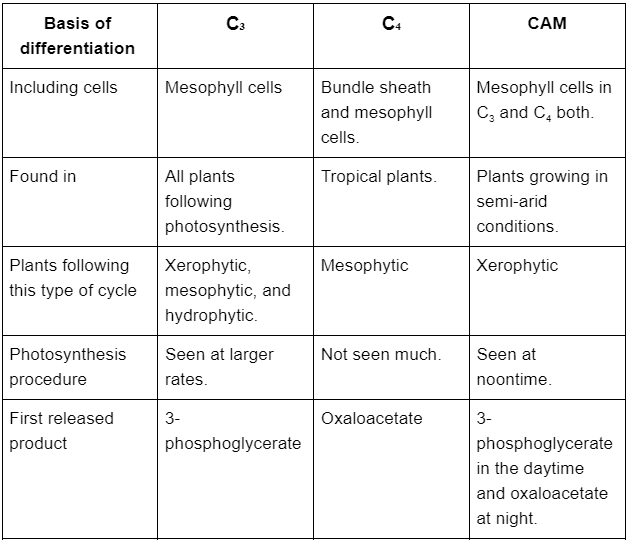C3, C4 and CAM Mechanisms - 1 | Agriculture Optional Notes for UPSC PDF Download
| Table of contents |

|
| C₃ Pathway |

|
| C₄ Pathway |

|
| CAM Pathway |

|
| Difference Between C₃, C₄, and CAM Pathway |

|
C₃ Pathway
- The C₃ pathway, also known as the C₃ photosynthetic pathway, is the most common of the three pathways used for carbon fixation in the process of photosynthesis. It is associated with typical plants that lack specialized adaptations to minimize photorespiration. C₃ plants employ a standard mechanism for carbon fixation by using the enzyme ribulose-1,5-bisphosphate carboxylase/oxygenase (RuBisCO), which is the first enzyme involved in the Calvin Cycle. This pathway is prevalent in approximately 85 percent of all plant species on Earth, encompassing a wide range of plants such as rice, wheat, soybeans, and most trees.
- In the C₃ pathway, the following reaction occurs, leading to the production of two molecules of 3-phosphoglycerate:
- CO₂ + H₂O + RuBP -> (2) 3-phosphoglycerate
- This represents the initial step within the Calvin-Benson cycle. Plants that solely utilize the C₃ pathway, often referred to as C₃ plants, tend to thrive in environments characterized by:
- Moderate sunlight,
- Moderate temperatures,
- Carbon dioxide concentrations at approximately 200 parts per million (ppm) or higher,
- Sufficient groundwater availability.
Note: It's worth noting that C₃ plants have their origins dating back to the Paleozoic and Mesozoic eras and precede the evolution of C₄ plants. These C₃ plants account for nearly 95 percent of the plant biomass on Earth, including essential food crops like rice, soybeans, wheat, and barley.
C₄ Pathway
- The Hatch-Slack pathway, also known as C₄ carbon fixation, is an alternative photosynthetic process used by certain plants. This pathway involves the initial step of converting carbon dioxide (CO₂) into a four-carbon molecule, which can then be used for the synthesis of sucrose (sugar) and other essential biomolecules.
- Plants that employ the C₄ carbon fixation pathway have several advantages over those using the C₃ pathway, particularly in harsh environmental conditions such as high temperatures, drought, and low concentrations of carbon dioxide and nitrogen. For example, if we compare C₃ and C₄ grasses growing in a similar environment at 30 degrees Celsius, it is evident that C₄ grasses lose only approximately 277 molecules of water for each molecule of carbon dioxide, while C₃ grasses lose a significantly higher number, around 833 molecules of water.
- Around 8,100 plant species have adopted the C₄ pathway, and all of them belong to the angiosperms (flowering plants). The Poaceae family, which includes various grass species, predominantly utilizes C₄ carbon fixation.
Some important crops that belong to the C₄ group include:- Sugar cane
- Maize (corn)
- Millet
- Sorghum
CAM Pathway
The Crassulacean Acid Metabolism, or CAM pathway, represents the third approach to carbon fixation in plants. CAM plants have a unique strategy where their stomata remain closed during the daytime to minimize water loss through transpiration. Instead, they open their stomata during the night to take in carbon dioxide, which is stored in the form of organic acids in mesophyll cells.
Here is a breakdown of the two-phase cycle that characterizes the CAM pathway:
Nighttime
- CAM plants open their stomata at night, allowing the entry of carbon dioxide.
- Carbon dioxide is fixed into organic acids through a reaction involving phosphoenolpyruvate (PEP).
- The final organic acids are stored in vacuoles for later use since the Calvin cycle cannot function without the necessary NADPH and ATP in the absence of light.
Daytime
- To conserve water, CAM plants keep their stomata closed during the daytime.
- The stored organic acids release carbon dioxide.
- An enzyme in the stroma of the chloroplast generates carbon dioxide, which enters the Calvin cycle to support photosynthesis.
- CAM plants are typically found in regions where water availability alternates between scarcity and abundance. Examples of CAM plants include cacti, agave, and clusia pratensis. This carbon fixation mechanism is also observed in aquatic plants, such as Isoetes, Littorella, Crassula, and Sagittaria.
Now that you have an understanding of C₃, C₄, and CAM carbon fixation processes individually, let's explore the differences between these pathways.
Difference Between C₃, C₄, and CAM Pathway


The key difference among C₃, C₄, and CAM photosynthesis lies in how they handle carbon fixation and their adaptation to different environmental conditions. C₃ photosynthesis involves the direct production of a three-carbon compound through the Calvin cycle. In contrast, C₄ photosynthesis initially forms a four-carbon compound, which then splits into a three-carbon compound for the Calvin cycle. CAM photosynthesis, on the other hand, collects sunlight during the day and fixes carbon dioxide at night.
C₃ photosynthesis is the most common type and is found in a majority of plant species. In contrast, C₄ photosynthesis is employed by a smaller fraction of vascular plants, about 3%, including examples like crabgrass, sugarcane, and corn. CAM photosynthesis is utilized by plants adapted to arid environments, such as cacti and pineapples.
These different photosynthesis pathways have evolved to cope with photorespiration, a wasteful process that occurs in certain conditions. C₃ plants don't have specific mechanisms to combat photorespiration, while C₄ plants overcome it by separating carbon dioxide fixation and the Calvin cycle into different cells. CAM plants, on the other hand, minimize photorespiration by conducting carbon dioxide fixation and the Calvin cycle at different times, separating day and night.
FAQs on C3, C4 and CAM Mechanisms - 1 - Agriculture Optional Notes for UPSC
| 1. What is the C₃ pathway? |  |
| 2. What is the C₄ pathway? |  |
| 3. What is the CAM pathway? |  |
| 4. What are the differences between the C₃, C₄, and CAM pathways? |  |
| 5. Which plants use the C₄ and CAM pathways? |  |

|
Explore Courses for UPSC exam
|

|


















